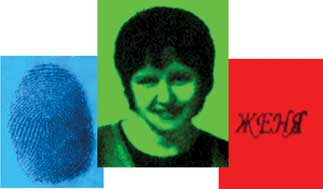| Posted: January 24, 2007 |
Stopping ID fraud with nanotechnology |
|
(Nanowerk News) Your identity could be made safer thanks to Canadian scientists.
|
|
Eugenia Kumacheva from University of Toronto and colleagues have developed a nanostructured polymer material that can be used to record biometric features, such as fingerprints, photos and signatures. They claim that this technology could help prevent counterfeiting and identity fraud ("Polymer nanostructured material for the recording of biometric features" – free access paper).
|
 |
| Fingerprint and photograph with biometric data. (Image: RSC Publishing)
|
|
Advances in laser and computer technologies have made forgery of documents such as ID cards easier. New, more complex materials are therefore needed. Kumacheva's group developed a polymer film containing three fluorescent dyes and recorded information in the film by selectively treating it with light. Using this technique, they recorded three different marks of identity on top of each other: a photograph, signature and fingerprint. These could then be seen by looking at the film under different wavelengths. The researchers estimate that these films could produce ID cards that would be stable to daily reading for up to four years.
|
|
"The researchers estimate that these films could produce ID cards that would be stable to daily reading for up to four years."
Kumacheva explained that her work was motivated by an urgent need for the protection of the identity of document holders. 'There are specific features in this technology that make it very difficult to counterfeit identification documents,' she said.
|
|
Luisa Torsi, an expert in polymer chemistry from the University of Bari, Italy, welcomes this work. 'This example proves that nanostructured materials hold the potential to make an impact in the recording and storing of biometric features,' she said.
|

